 |
 |
 |
| |
Characterization of Virologic Failure Over 96 Weeks by Drug Resistance and Antiviral Response in ART Naïve Patients Receiving Abacavir/Lamivudine (ABC/3TC) or Tenofovir/Emtricitabine (TDF/FTC) Each with Lopinavir/Ritonavir QD in the HEAT Study
|
| |
| |
Reported by Jules Levin
ICAAC/IDSA Oct 27 2008 Wash DC
B. Young1, K. Smith2, P. Patel3, M. Markowitz4, D. Berger5, P. Wannamaker3, L. Yau3, and C. Vavro3
1Rose Medical Center, Denver, CO; 2Rush Med Ctr, Chicago, IL, 3GSK, RTP, NC; 4ADARC, NY, NY; 5NorthStar Med Ctr, Chicago, IL
BACKGROUND
The HEAT study is the first head-to-head study to evaluate the efficacy and safety of the dual NRTI backbones Epzicom and Truvada each in combination with Kaletra in ART- naïve patients
At week 48 non-inferiority of Epzicom to Truvada was established and at week 96 Epzicom remained virologically comparable to Truvada (Smith, 2008).
OBJECTIVES
To compare the proportion of subjects with protocol-defined virologic failure receiving Epzicom QD versus Truvada QD when each was given in combination with Kaletra QD over 96 weeks in ART-naïve HIV-1 infected subjects
To characterize resistance patterns that arise in subjects experiencing virologic failure while on study
AUTHOR CONCLUSIONS
The number of subjects with protocol-defined virologic failure was similar between the two treatment groups [ABC/3TC: 14% vs TDF/FTC: 14%]
The TDF/FTC treatment group had 63% of subjects experiencing virologic failure in the baseline HIV-1 RNA strata of <100,000 c/mL, while the ABC/3TC treatment group had 59% of subjects experiencing virologic failure in the baseline HIV-1 RNA strata of >100,000 c/mL.
Subjects with virologic failure receiving ABC/3TC had fewer mutations or mixtures of mutations at codon 184 as compared to subjects receiving TDF/FTC.
Treatment-emergent PI-associated mutations were rare.
AUTHOR DISCUSSION
Overall virologic failure rates were similar across both treatment arms. Among subjects with baseline HIV-1 RNA <100,000 c/mL, more TDF/FTC subjects experienced virologic failure (ABC/3TC: 41%; TDF/FTC: 63%). Among subjects with baseline HIV-1RNA >100,000 c/mL more subjects receiving ABC/3TC experienced virologic failure (ABC/3TC: 59%; TDF/FTC: 37%)
Among subjects experiencing virologic failure with treatment emergent mutations, mutations at codon 184 were more common among subjects receiving TDF/FTC than subjects receiving ABC/3TC. Phenotypic analyses confirmed the importance of the genotypic findings for the TDF/FTC treatment group.
One subject receiving ABC/3TC + LPV/r developed PI and NRTI-associated mutations. Additional analyses (not shown) suggest that this may represent a case of HIV superinfection with a multi-drug resistant viral strain.
African American subjects were more likely to experience virologic failure; these observations were corroborated by univariate and multivariate analyses predicting virologic failure.
Methods
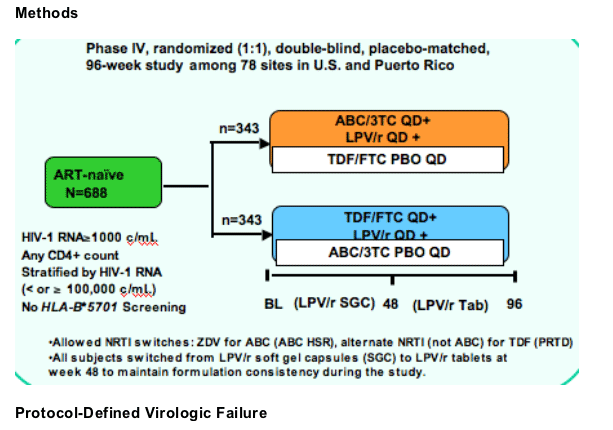
Failure to achieve HIV-1 RNA <200 c/mL or confirmed rebound to ≥ 200 c/mL after confirmed reduction to <50 c/mL by week 24.
Confirmed HIV-1 RNA ≥ 200 c/mL after week 24.
VIRUS CHARACTERIZATION
Viral samples taken at baseline and time of virologic failure were tested at Monogram BioSciences, Inc. (MBI) using PhenoSense GTTM.
Drug resistance genotypic profiles were generated using IAS Resistance Guidelines (Fall 2007)
Phenotypic profiles for drug susceptibility were generated using the MBI clinical (where possible) and biological cut offs.
Statistical Analysis
Virology analyses are based on the ITT (E) population
Descriptive statistics of genotypic and phenotypic findings by treatment group were summarized
Association of each baseline variable with virologic failure was studied using univariate logistic regression models. In the analysis categorical variables were given a value of 1 or 0 (e.g. Male vs Female==> Male = 1, Female = 0).
Final logistic regression model included significant baseline variables (p<0.05) from the univariate analyses and retained only significant variables (p<0.05) selected by the stepwise selection method.
RESULTS
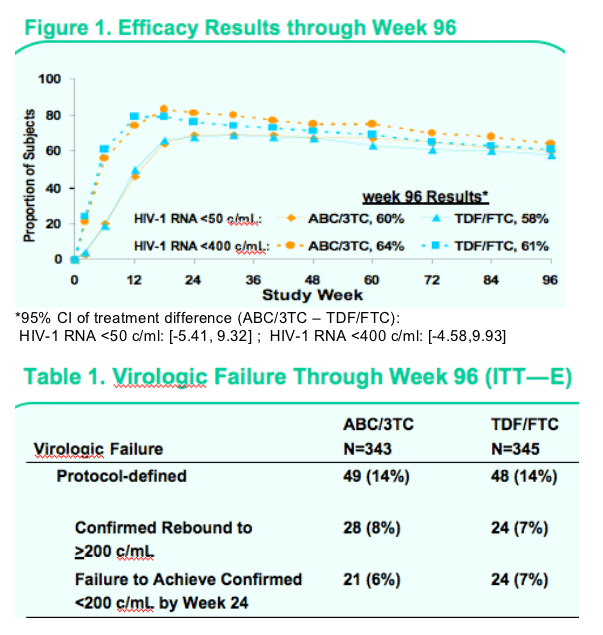
Baseline characteristics for subjects with virologic failure match those of the full study with two exceptions, race and baseline plasma HIV-1 RNA.
36% of subjects in the full study were African American but 56% of subjects experiencing virologic failure were African American [ABC/3TC: 22 (45%); TDF/FTC: 30 (63%)].
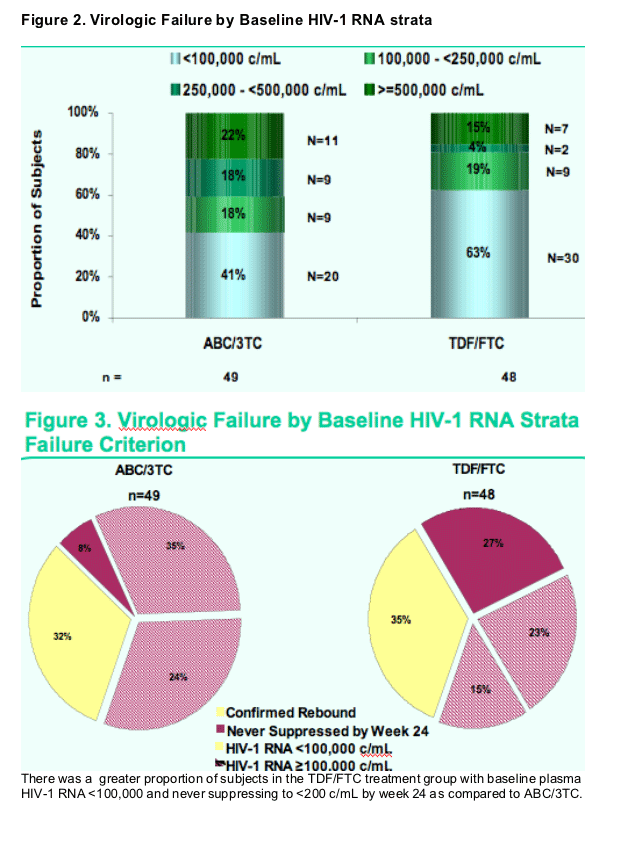
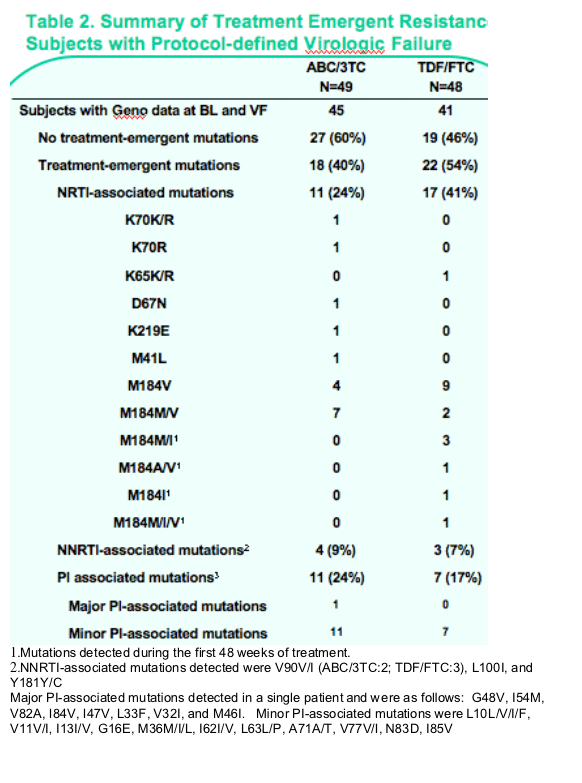
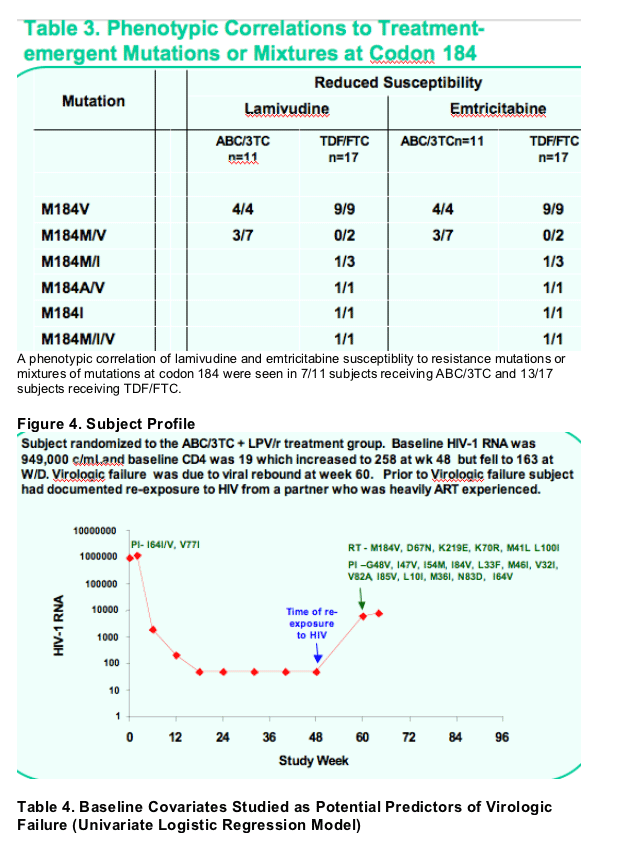
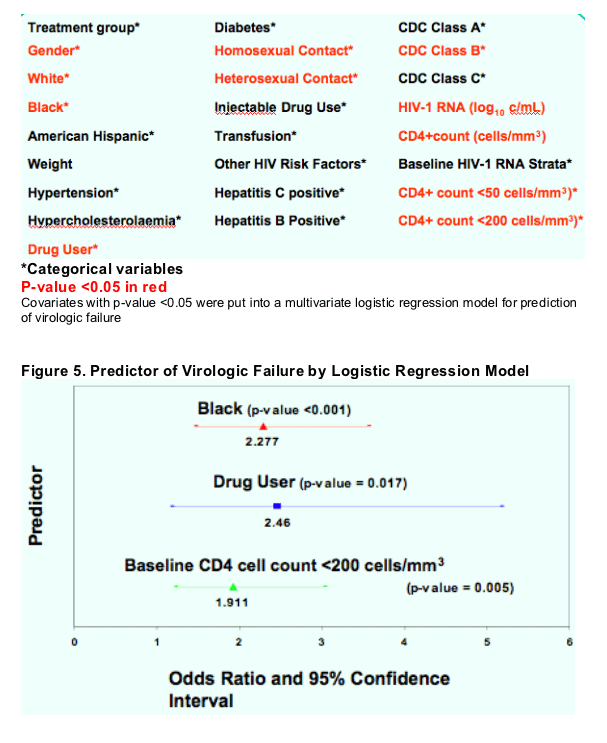
REFERENCE
Smith , K; Fine, D; Patel, P; et al. Similarity in Efficacy and Safety of Abacavir/Lamivudine (ABC/3TC) Compared to Tenofovir/Emtricitabine (TDF/FTC) in Combination with QD Lopinavir/Ritonavir (LPV/r) Over 96 Weeks in the HEAT Study. 18th International AIDS Conference, Mexico City, Mexico, Aug.3-8, 2008
|
| |
|
 |
 |
|
|